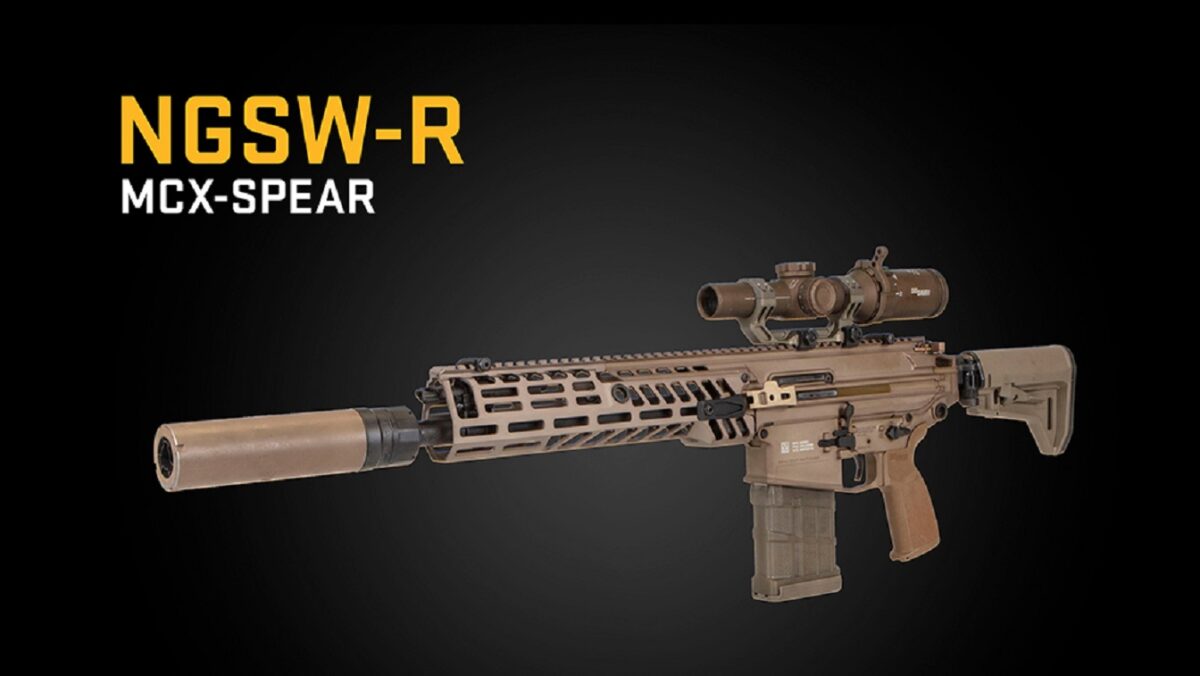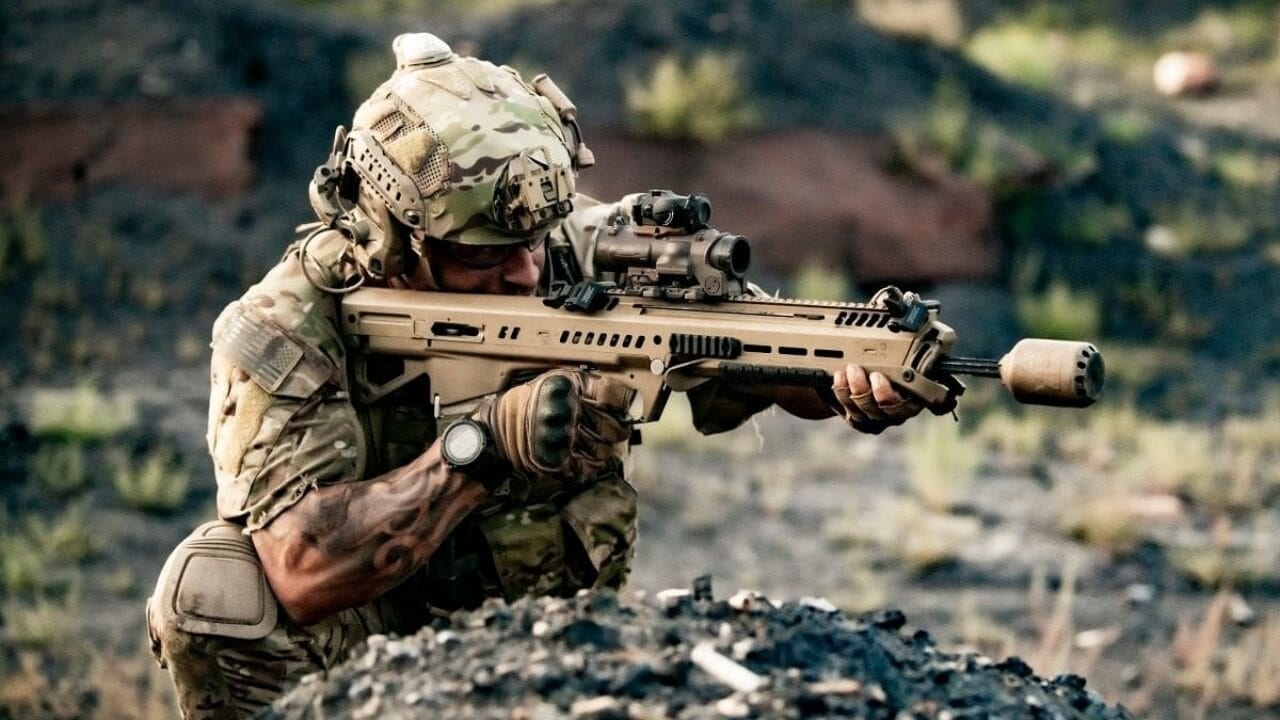While many military experts love to discuss the latest aircraft carrier for stealth fighters, the U.S. military needs small arms to ensure the Army and Marines along with other forces, have the firepower they need on any battlefield. That means the Next Generation Squad weapon or NGSW, is vital to our overall defense.

SIG Sauer NGSW. Image Credit: Creative Commons.
The Next Generation Squad Weapon contest (or NGSW) has been interesting to watch. The three main vendors, SIG Sauer, General Dynamics – OTS, and Textron Systems, brought revolutionary weapons and ammunition to the competition. In April, the U.S. Army chose the SIG NGSW. This two-weapon contest featured both a rifle and an automatic rifle.
The contract lasts ten years, and the initial delivery is worth $20.4 million. The contract will include weapons, ammo, spare parts, and contractor support for the new firearms. Additional weapons will be provided for DoD forces, which likely means the Marine Corps. The three competitors underwent a 27-month evaluation process that looked at technical specifications and what the Army calls Soldier touch points.
Soldier touch points combine immersive testing and feedback mechanisms that guide product development. It’s a fancy way of saying they give it to the grunts, and grunts give them feedback on how it works when fielded. Sadly, this hasn’t always been a part of development and modernization, so it’s nice to see the Army taking it seriously. It also improves my confidence in the new weapon systems.
The NGSW will not fully replace the M4 within the U.S. Army at first. Instead, the weapon will be given to close combat forces. That likely means the infantry, combat engineers, and similar combat arms forces.
The SIG NGSW rifle
SIG’s rifle entry is essentially an NGSW version of the MCX Spear and will be known as the XM5. The Spear is the heavy-duty version of the MCX and chambers full-powered rifle rounds. The MCX series rifles are short-stroke, gas-piston guns that take their ergonomics from the AR-15 platform. Soldiers trained with the M4 won’t have any issues adapting to the SIG’s controls. Those controls will likely be ambidextrous and make the rifle better suited to all shooters.
The use of a short-stroke gas piston system offers several advantages. Unlike the direct impingement M4, the XM5 will not need a receiver extension and dedicated buffer. This allows the weapon to have a folding stock, making it reasonably compact for storage options. The short-stroke gas piston system works very well with shorter barrels and suppressors.
The XM5 rifle will seemingly utilize a modern lightweight, M-LOK rail system with a free-floated barrel for superior accuracy. The weapon will weigh approximately 8.38 pounds.
The SIG NGSW automatic rifle
Automatic rifles is an interesting concept. In this case, it comes in the form of a belt-fed, open-bolt machine gun. The SIG NGSW automatic rifle, the XM250, is a highly modern and intriguing machine gun. Users can quickly load the gun with the feed cover closed, meaning big optics aren’t threatened by the hot barrel, and reloads can be done while keeping a low profile. The hinged top cover ensures complete and total accuracy with a mounted optic.
Opening and closing the feed tray cover of a traditional machine gun would often cause a zero shift. The top cover didn’t close in the same position every time. The XM250 features a unique hinge and latch system that ensures it closes the same way every time.
An adjustable gas system allows the user to operate with a suppressor efficiently and effectively. An adjustable gas system ensures the extra backpressure from a suppressor doesn’t create excessive recoil.
As a machine gunner, the weapon’s weight surprised me. It weighs less than 13 pounds, making it almost five pounds lighter than the 5.56 caliber M249 SAW. The weapons we’ve seen wear adjustable stocks, M-LOK handguards, and a lot of optics rail space.
The Ammo
The Army had some strict demands for the ammunition provided with the two weapons. The round would use a 6.8 caliber projectile. The round needed to provide a greater effective range than the 5.56 caliber round and be more accurate than the 7.62mm NATO round. The SIG NGSM entry utilizes a 6.8x51mm round, also known as the .277 Fury in the civilian world.
The advantages of the NGSW
The SIG NGSW weapons have some serious advantages. They are both incredibly modern, more accurate, offer a tremendous effective range, and can be a threat to modern body armor. The rifle and automatic rifle will allow soldiers to engage at greater distances with more effective fire.
The new Fire Control Unit from Vortex will be on both guns, and it’s essentially a targeting computer on a 1-8X optic. The combination of rifle, round, and optic seems to aim to turn every soldier into a quasi-designated marksman.
The drawbacks
While the SIG NGSW automatic rifle will be lighter than the SAW, the rifle counterpart comes in about two pounds heavier. The ammunition might be more lightweight than other full-powered rifle rounds but heavier than the little 5.56 round. Additionally, there will be increased recoil. I’ve not fired the NGSW, but I have fired the SIG Cross in .277 Fury, and the recoil was stout.
In a semi-auto rifle, it will be lighter but still considerably more than a 5.56. At closer ranges, this will make the rifle more challenging to control. At close quarters, speed rules and repeated shots are the name of the game. The larger, heavier, and harsher XM5 might be a challenge in close-quarter fighting.
Since I’ve not trained with the weapon, this is pure speculation and shouldn’t be taken as the gospel.
The Future
The round is capable of speeds in excess of 3,000 feet per second from a16 inch barrel. The speed and weight of the projectile make it a serious threat against armor and hardcover. This does mean a chamber pressure of 80,000 PSI, approximately 20,000 PSI more than a 7.62 NATO round.
There is also a demand for lighter ammunition, and SIG met this demand by using a steel case head. The hybrid design ensures reliable operation with high pressures and a weight reduction. It’s a fascinating cartridge that won’t require any special machinery. Rounds can be loaded at good ole Lake City. This hybrid design can be moved to other rounds as well.
I’m most excited about the technology used to build the cartridge. It’s fascinating how fast, efficient, and light ite is. That technology might be the next leap forward in small arms design. The XM5 and XM250 are both extraordinarily modern and will certainly offer advantages in range, accuracy, and when facing armored threats. We moved from the M14 for numerous reasons.
Not only was the M14 a terrible rifle, but the ammo was heavy, the rifle was heavy, and the recoil was heavy. The 5.56 round gave soldiers more ammo and a more maneuverable gun. We’ve followed that trend of lightening the weapon’s load since and are now changing course in a significant way. It’s interesting to watch, and you can be assured we’ll keep a sharp eye on the NGSW.

